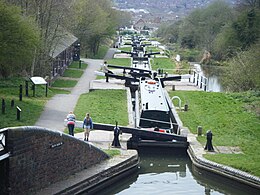Delph Locks
| Delph Locks | |
|---|---|
 The flight from lock 2 | |
 | |
| Waterway | Dudley Canal |
| Maintained by | Canal & River Trust |
| Operation | Manual |
| First built | 1799 |
| Length | 70 feet (21.3 m) |
| Width | 7 feet (2.1 m) |
| Fall | 85 feet (26 m) |
| Above sea level | top lock: 441 feet (134 m) |
| Flight of 8 locks | |
Delph Locks or the Delph Nine are a series of eight (originally nine) narrow
History
The Dudley Canal and the
Engineer
The bottom lock at Black Delph Bridge is at the termination of the Dudley Canal and forms the boundary with the Stourbridge Canal. The flight has distinctive waterfall overflow weirs,[2] and rises from the 356-foot (109 m) Stourbridge level to the 441-foot (134 m) level of the Dudley No. 1 canal.[3] The middle seven of the original 1779 locks were rebuilt in 1858 as six new locks, reducing the flight to eight. Some ruins of the old locks are visible to the side of the new.[2]
The two canals ceased to carry commercial traffic, and by the early 1950s were unusable.
Location
The Delph Locks and surrounding land form the Delph 'Nine' Locks Conservation Area, Brierley Hill,
From the top of the flight, the Dudley Canal is level for 1.8 miles (2.9 km) to Blowers Green Lock and the junction with the Dudley No. 2 Canal.[9] From the bottom of the flight, the Stourbridge Canal is level for the same distance to Leys Junction,[10] where the Fens Branch heads to the north east and the Fens Pools reservoirs, while the main line descends 145 feet (44 m) through a flight of sixteen locks.[11]
See also
Bibliography
- Cumberlidge, Jane (2009). Inland Waterways of Great Britain (8th Ed). Imray Laurie Norie and Wilson. ISBN 978-1-84623-010-3.
- Hadfield, Charles (1985). The Canals of the West Midlands. David and Charles. ISBN 0-7153-8644-1.
- ISBN 978-0-00-721110-4.
- Pearson, Michael (1989). Canal Companion - Birmingham Canal Navigations. J. M. Pearson & Associates. ISBN 0-907864-49-X.
- Squires, Roger (2008). Britain's restored canals. Landmark Publishing. ISBN 978-1-84306-331-5.
References
- ^ Hadfield 1985, pp. 73–77
- ^ a b Nicholson 2006, p. 130
- ^ a b Pearson 1989
- ^ Nicholson 2006, p. 127
- ^ Squires 2008, pp. 40, 50–51
- ^ Cumberlidge 2009, p. 280
- ^ Dudley Conservation Areas Archived 2008-06-08 at the Wayback Machine
- ^ Historic England. "Lock Keeper's House, Dudley (1279272)". National Heritage List for England. Retrieved 17 March 2012.
- ^ Cumberlidge 2009, p. 79
- ^ Cumberlidge 2009, p. 281
- ^ Nicholson 2006, pp. 128–129
External links
- Grade II, historicengland.org.uk. Accessed 11 December 2022.
 Media related to Delph Locks at Wikimedia Commons
Media related to Delph Locks at Wikimedia Commons
